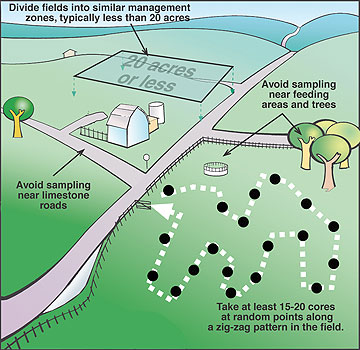From the Vine: Why Soil Sampling Is Essential for Gardens, Lawns, and Crops
go.ncsu.edu/readext?1036337
en Español / em Português
El inglés es el idioma de control de esta página. En la medida en que haya algún conflicto entre la traducción al inglés y la traducción, el inglés prevalece.
Al hacer clic en el enlace de traducción se activa un servicio de traducción gratuito para convertir la página al español. Al igual que con cualquier traducción por Internet, la conversión no es sensible al contexto y puede que no traduzca el texto en su significado original. NC State Extension no garantiza la exactitud del texto traducido. Por favor, tenga en cuenta que algunas aplicaciones y/o servicios pueden no funcionar como se espera cuando se traducen.
Português
Inglês é o idioma de controle desta página. Na medida que haja algum conflito entre o texto original em Inglês e a tradução, o Inglês prevalece.
Ao clicar no link de tradução, um serviço gratuito de tradução será ativado para converter a página para o Português. Como em qualquer tradução pela internet, a conversão não é sensivel ao contexto e pode não ocorrer a tradução para o significado orginal. O serviço de Extensão da Carolina do Norte (NC State Extension) não garante a exatidão do texto traduzido. Por favor, observe que algumas funções ou serviços podem não funcionar como esperado após a tradução.
English
English is the controlling language of this page. To the extent there is any conflict between the English text and the translation, English controls.
Clicking on the translation link activates a free translation service to convert the page to Spanish. As with any Internet translation, the conversion is not context-sensitive and may not translate the text to its original meaning. NC State Extension does not guarantee the accuracy of the translated text. Please note that some applications and/or services may not function as expected when translated.
Collapse ▲As the fall season winds down and winter approaches, it’s a prime time to think about the health of your soil. Soil sampling is a crucial step for home gardeners, landscapers, and farmers alike, helping ensure that soil conditions are optimal for the coming growing season. Through a soil test, you can learn about the soil’s pH, nutrient levels, and texture—key factors that influence the health and productivity of plants.
With a detailed soil report, gardeners can avoid the common mistake of over-fertilizing or using unnecessary soil amendments. Instead, they can apply only what is needed, which is better for both plant health and the environment. Following tailored recommendations from a soil test also helps reduce the chances of nutrient leaching into water systems.
Understanding the NCDA&CS Soil Testing Process and Fees
The North Carolina Department of Agriculture & Consumer Services (NCDA&CS) offers a soil testing service, making it easy to get detailed soil health information. While soil testing is typically free for North Carolina residents from April through November, a peak season fee goes into effect each winter when demand for soil testing is highest.
For 2024, the NCDA&CS will start charging a $4 fee per sample beginning November 27 and continuing through March 31, 2025. To avoid this fee, soil samples must arrive at the lab no later than 5 p.m. on November 26. If you’re planning to submit samples through your local Extension office, you’ll need to drop them off by noon on November 25 to allow for delivery to the lab before the deadline.
Steps for Effective Soil Sampling
- Gather Your Materials: Use a soil probe or spade, a clean plastic bucket, and sample boxes (available at your local Extension office).
- Take Multiple Samples: Collect samples from different areas of your lawn, garden, or field to get a representative soil sample.
- Mix and Prepare: Mix the soil thoroughly in the bucket, then transfer it to the sample box. Label each sample by location to ensure accurate analysis.
- Submit to Your Local Extension Office or NCDA&CS: Follow local guidelines for submission to ensure timely delivery.
Benefits of Soil Testing for Different Land Uses
- Home Gardens and Landscapes: Helps adjust soil pH and nutrients for various plants, from vegetables to ornamental plants.
- Lawns: Assists in achieving lush, green grass while reducing fertilizer runoff.
- Agronomic Crops: Optimizes yield and quality by providing crop-specific nutrient recommendations.
This fall, don’t miss the chance to make data-driven decisions that will help your plants thrive. Visit your local Extension office or the NCDA&CS website for more information on soil testing, and remember to submit your samples by November 26 to avoid the peak season fee.




